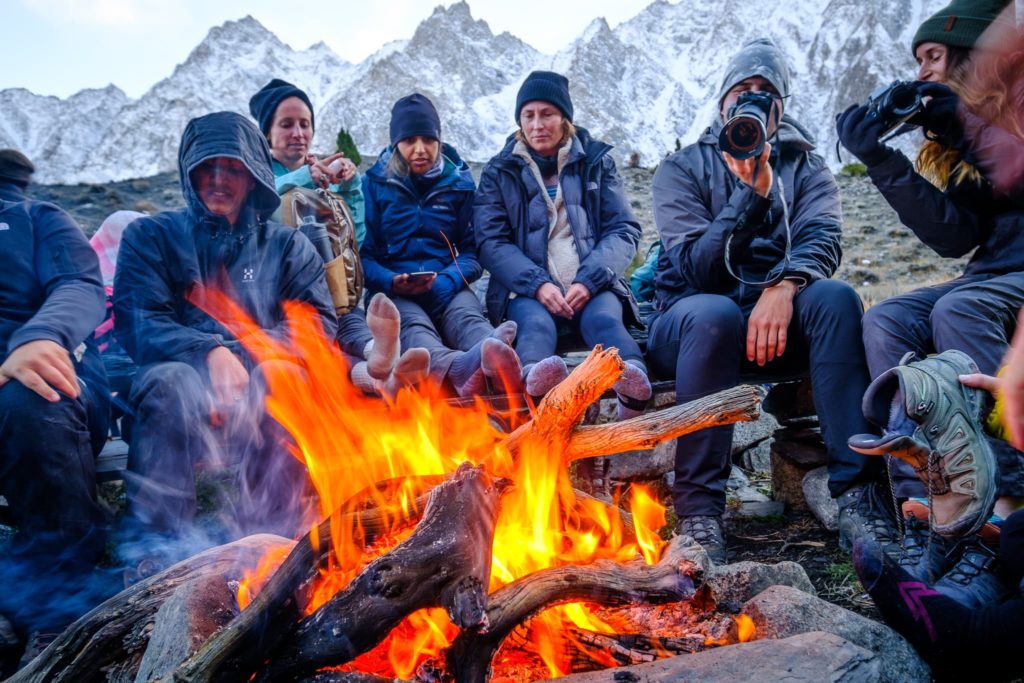Fresh socks. There is nothing in this world quite as joyful as putting on a clean new pair; and the same is true of hiking socks!
Often, when we think about our hiking essentials, we consider the most obvious parts of our gear setup. Backpacks… Rain jackets… Head torches…
But how often do we stop to consider the best material for our hiking socks?
Knowing what type of socks to use for hiking is instrumental. It all starts with our feet: that shoe-meets-sock combo is essential to our entire setup. If we get that wrong on the trail, we’re in serious trouble.
It’s time you enhanced your hiking experience with a rock-solid foundation. Don’t let something as solvable as poor hiking socks be what stands between you and the adventure of a lifetime.
Let’s explore the best hiking sock materials and types so you can get to what really matters. Hiking comfortably in nature, just as she intended.
Why Choosing the Right Hiking Sock is So Important
A great pair of hiking socks makes all the difference on the trail. They cover your feet, sure. However, they’re also a crucial part of both your comfort and performance
The wrong sock size? Blisters.
The wrong sock fabric? Wet feet and unregulated temperature.
Socks work with your hiking boots symbiotically. They’re a team for the trails! Together, they provide proper support and cushioning, making them an essential part of hiking foot care for long-term comfort.
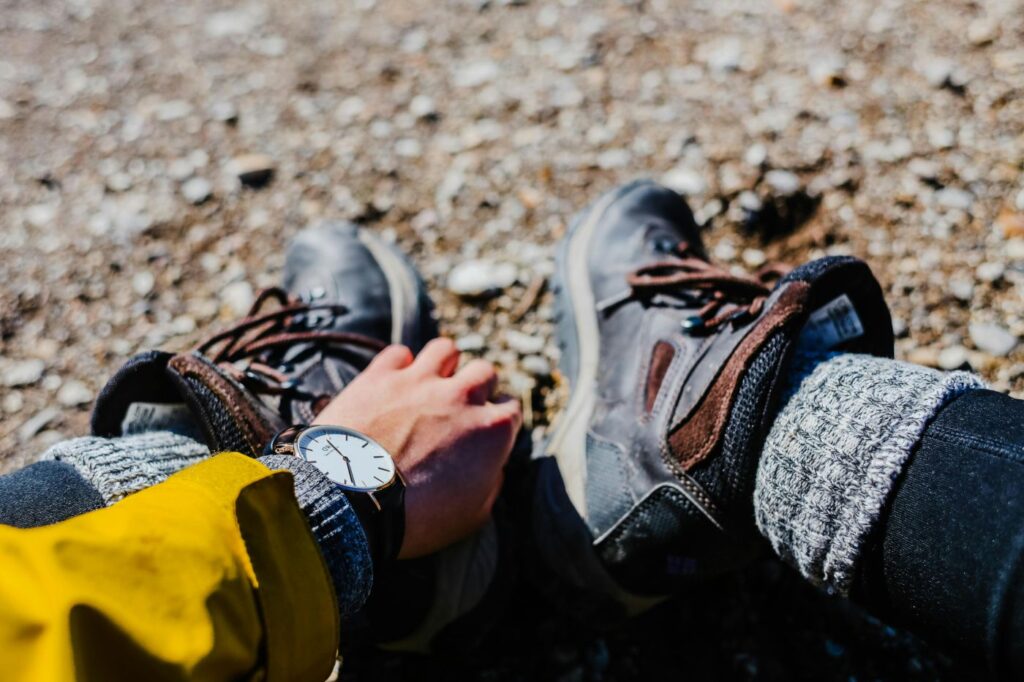
A poorly chosen pair—either too thin, too thick, or just made from the wrong materials—can lead to hot spots, excess sweating, or even cold feet in chilly conditions. (Not to mention blisters and skin abrasions.)
The bottom line is that choosing the best hiking sock types and materials matters. This choice can quite legitimately be the deciding factor between an amazing adventure and a miserable one. The conversation around what the best socks to wear for hiking are might get overlooked sometimes…
But that’s why we’re diving in feet first! Because hikers need healthy hooves.
And it all starts with your socks.
Hiking Sock Material Overview
Not all hiking socks are made for the same mileage. Different cuts, different fabrics… Wool vs polyester socks vs other synthetics and all the alternatives…
It’s a lot to break down!
It’s key to note that the best material for hiking socks prioritizes:
- Moisture management
- Insulation
- Durability
- Comfort
This is the angle from which we’re approaching the analysis. The right socks for backpacking (or even a chill day hike for that matter) need to wick sweat away, dry quickly, and provide cushioning without feeling bulky. This keeps your temps terrific and your blisters non-existent.
So now we’ve dipped our toes, let’s wade in a bit further.
Merino Wool
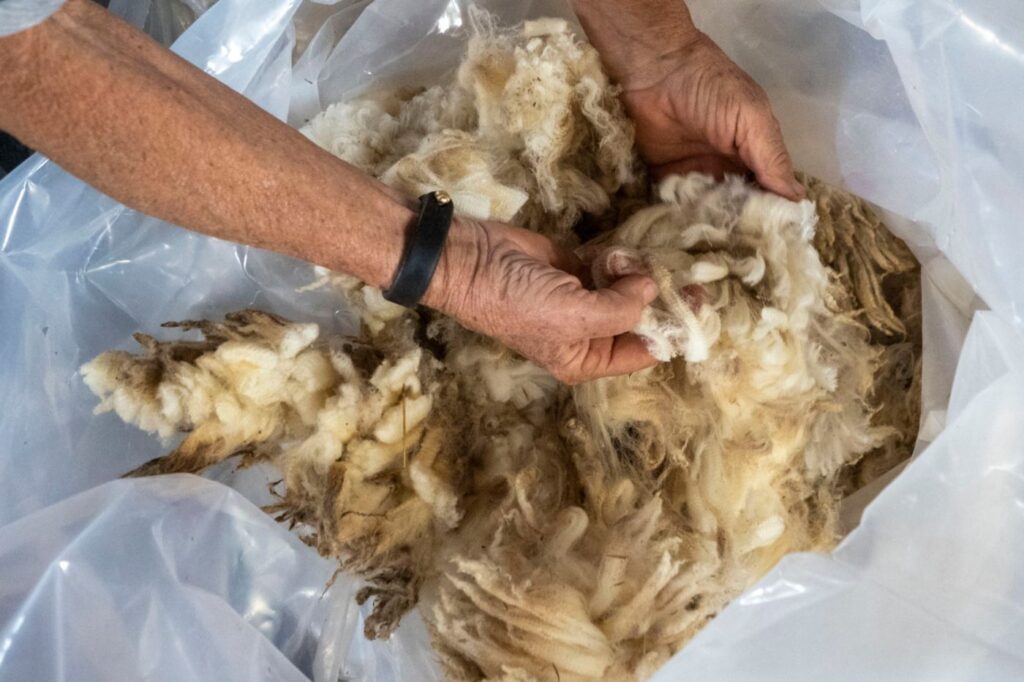
Are wool socks good for hiking? Abso-friggin-lutely! But you must make it merino.
Hailing from Spain but perfected by a lil’ Land Down Under (and their Kiwi cousins), merino wool is the gold standard. As one of the best sock materials for hiking, merino offers exceptional moisture-wicking, insulation, and odor resistance.
Unlike traditional wool, merino fibers are softer, finer, and non-itchy. As such, they’re much more comfortable for all-day wear on the trail.
Moreover, merino wool naturally regulates temperature. It keeps your feet warm in the cold and cool in the heat, making it an excellent year-round choice!
Plus, on top of merino’s relatively quick-drying capabilities, it retains warmth even when wet. This is especially critical for hiking in the rain, however, it’s also a massive boon for crossing streams, unexpected puddle missteps, or even general sweating.
Merino socks do tend to be pricier, but they also last a long time. They last particularly long if blended with synthetic fibers, so ideally look for 60%+ merino-synthetic mixes.
But really, if you are wondering what the outright best fabric for hiking socks is as a starting point, this is the pick of the pack for legendary trailblazers.
Synthetic
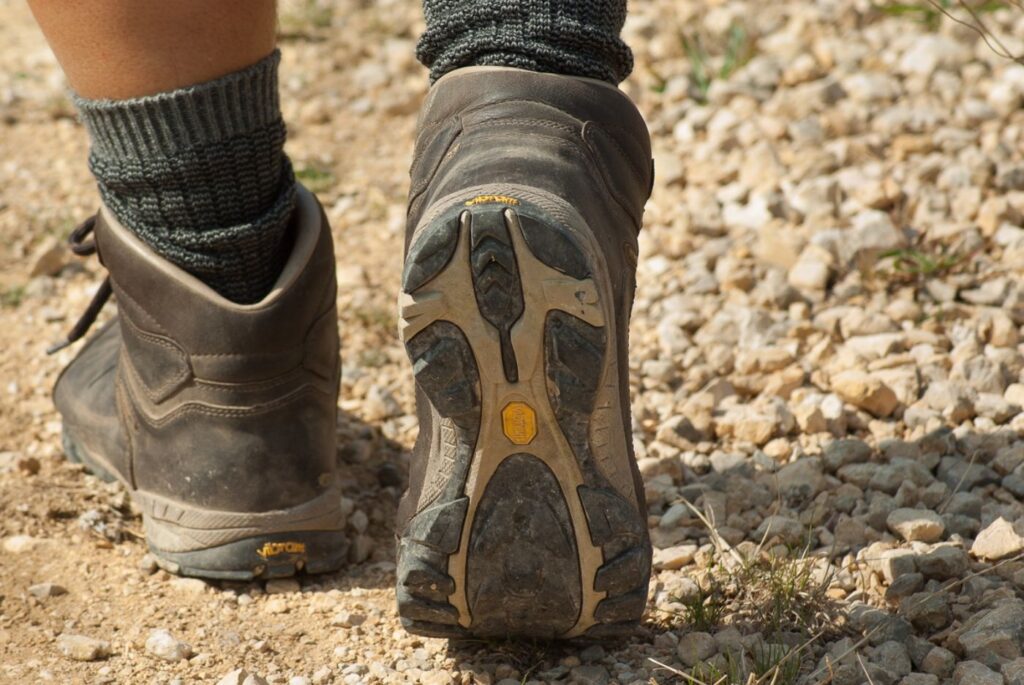
Synthetic materials cover a broader scope of fabrics than just merino. Most commonly, you’ll see:
- Polyester hiking socks
- Nylon hiking socks
- And, sometimes, spandex hiking socks
However, it’s rare to see a sock with 100% content of any of the above. Instead, they are commonly blended with other hiking sock materials for increased durability, elasticity, and faster drying.
Unlike wool, synthetic hiking socks don’t absorb moisture, meaning they dry significantly faster than even merino. As such, they’re another top-tier choice for wet conditions or sweaty feet.
Generally speaking, synthetic hiking socks are often more affordable than wool. You’re unlikely to get as much warmth from them, but they are thinner with minimal bulk.
Be warned though: synthetic hiking sock fabrics lack any natural odor resistance. As such, they aren’t always the best pick for serious multi-day trekkers. But if you’re looking for a neat hiking gift idea for the day hiker or trail runner in your life, synthetic is the solution for you!
Wool Alternatives
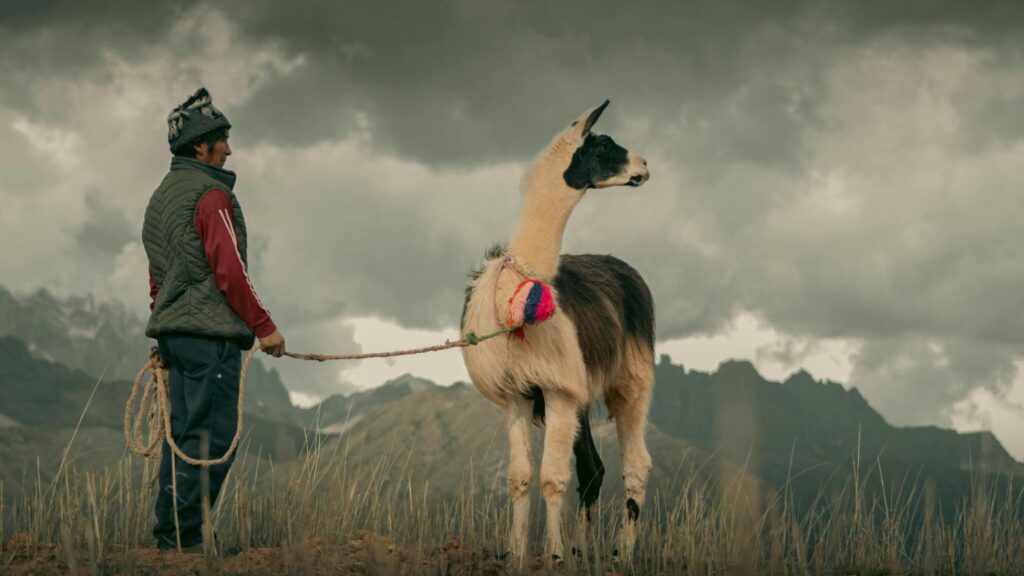
Not a fan of the merino magic? Both acrylic and alpaca are a couple of the best types of hiking socks in the alternative-wool weight class.
- Acrylic: This material mimics the insulation of wool but is actually fully synthetic. As such, it’s cheaper, hypoallergenic, and vegan-friendly! (Although it does lack some of merino’s odor-resistance.)
- Alpaca: Conversely, alpaca wool is the premium alternative to merino. It’s softer, warmer, more water-resistant, and even hypoallergenic for hikers with sensitive skin. However, generally, it comes at a higher price.
For high-altitude and extreme winter trekking, alpaca is one of the best types of hiking socks. The fibers are naturally hollow with enhanced insulation, providing the ultimate weight-to-warmth ratio.
Bamboo
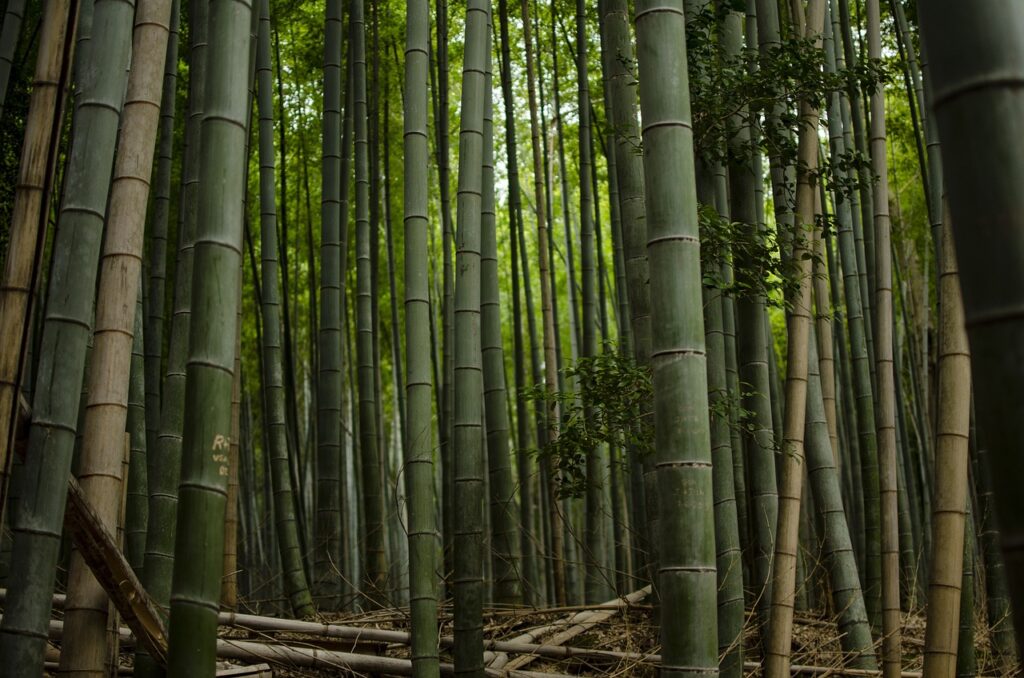
Bamboo is the new kid on the block. As a relatively recent upstart, it’s been making waves in the hiking community for its eco-friendly attitude, extreme breathability, and fantastic moisture-wicking properties when compared to other sock types.
Bamboo is an abundant and fast-growing material, making it super sustainable. Plus… it’s crazy comfy!
As a bonus, bamboo also has natural antibacterial properties. They’re a fantastic type of sock to wear with hiking boots—particularly in warmer weather—as they resist odors even better than synthetic materials!
The big downer is that they sacrifice durability. Bamboo fibers just can’t match the resilience of wool or synthetic fabrics. To compensate, you’ll find a lot of blended bamboo hiking socks that often include nylon or spandex to prevent rapid wear and tear.
Mixes and Blends
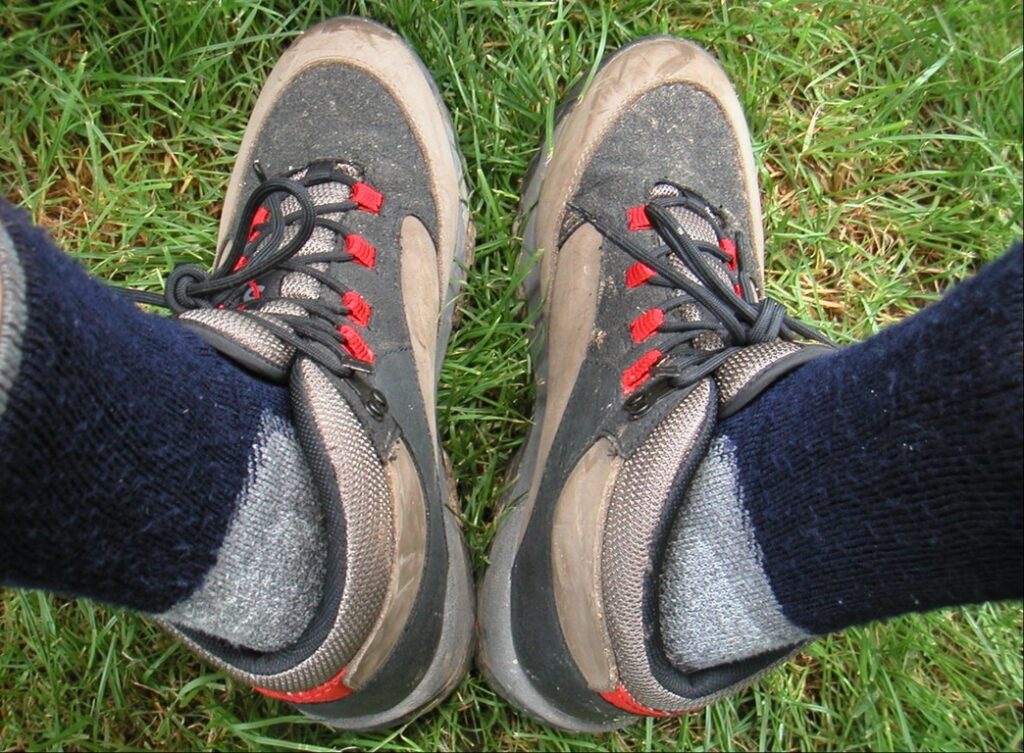
So these are all some fantastic materials for socks! But as we’ve already mentioned, often it’s the synergetic blend of these fabrics that ultimately makes for the best type of hiking sock overall. Why choose between wool or polyester or bamboo socks when you can just go for the combo!
Synthetic-merino wool hybrids are a gold standard for many hikers. Soft and warm; durable and stretchy—they offer the best of both worlds with superior drying capabilities.
Hikers who need compression socks, in particular, usually go for blends. Blended compression socks usually provide targeted support for calves and arches.
If nothing else and you still have lingering confusion, consider purchasing a blended pair of merino-synthetic socks. As far as versatility and longevity go, it’s one of the best materials for hiking socks, especially as a starting point. Then, you can just start experimenting with other sock fabrics from there!
Why You Should NEVER Wear Cotton Socks for Hiking
We’ve talked a lot about the best sock material for hiking… But what about the worst?
Cotton. Cotton, 100%, every time. There is NO such thing as good cotton hiking socks.
Ever heard of “cotton kills”? It’s not just a fun alliteration! It’s a real saying in the outdoor survival world.
Cotton has no place in wet or cold conditions for any of your hiking clothing, and certainly not for your socks. As a material, cotton absorbs moisture instead of wicking it away. Moreover, it dries incredibly slowly. Once cotton gets wet, be it from sweat or rain, it stays wet.
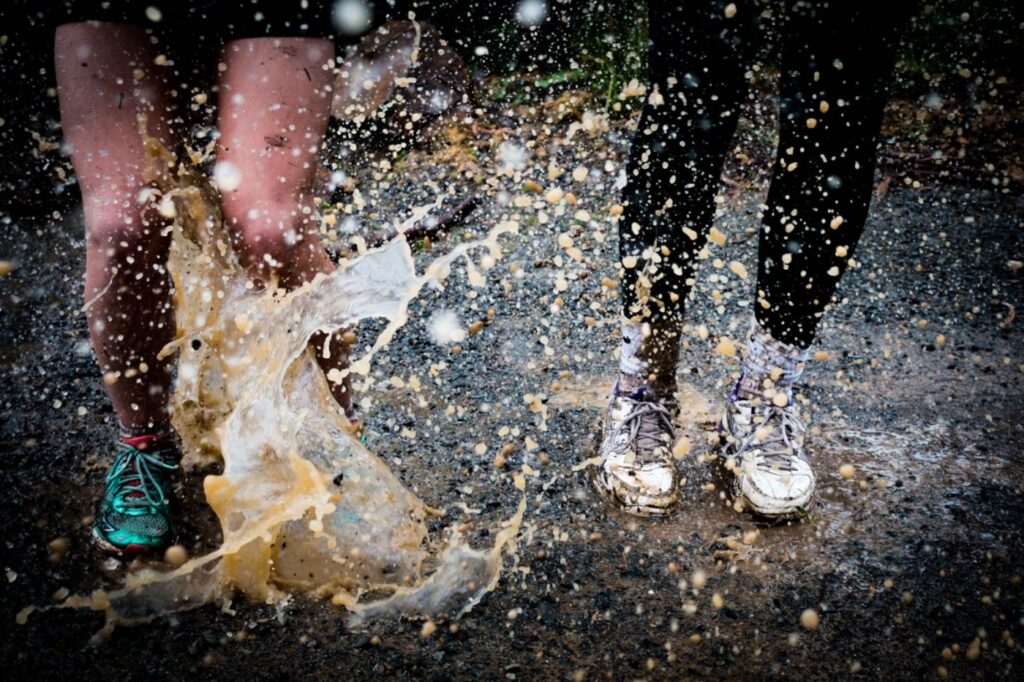
So as a material for hiking socks, cotton is a disaster! At best, you’re looking at increased friction and trapped moisture, leaving your feet vulnerable to blisters, swamp foot, and other nasties. Worst case scenario, wet cotton hiking socks will rapidly pull heat away from your body, causing severe temperature drops or even hypothermia.
So what’s the alternative? Anything but cotton.
And that goes for more than just your socks. No cotton tees… shorts… heck, even your undies should be any material but cotton.
The bottom line is that cotton fabric has no place in your hiking pack. Ever.
The Best Socks to Wear Hiking: Favorite Brands
So let’s talk about something you can count on! The best hiking socks in the business of blazing trails.
We’re going by brands, and first up we have the brand that nearly all the Epic Expeditions staff absolutely swear by: Darn Tough Socks. As the name would suggest, Darn Tough socks are built for bulletproof durability of near-indestructible quality. They’re so invincible that Darn Tough even backs them with a lifetime warranty!
In particular, we’re going to recommend the Darn Tough Hiker Micro Crew Cushion Socks coming in both a men’s cut and a women’s cut. As a midweight sock (61% merino wool, 36% nylon, 3% Lycra spandex), they’re a breathable and versatile all-arounder for year-round hiking conditions, complete with targeted cushioning for increased support and comfort.
However, while they might be the versatility-meets-durability pick, there are better options for extreme cold weather and high-altitude trekking. If the mountains is your destination, we would recommend a brand like Smartwool. More specifically, the unisex Smartwool Classic Mountaineer Maximum Cushion Crew Socks.
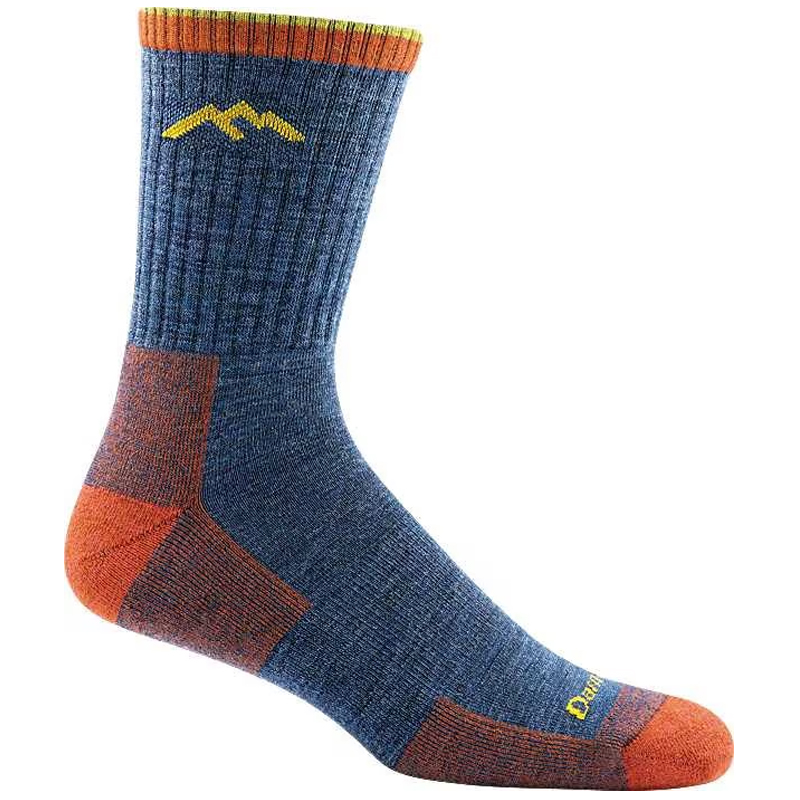
As a 73% merino wool and synthetic blend with elastane in the design, this mountaineering choice offers higher levels of insulation and cushioned comfort to the Darn Tough Micro Crew choice, poising them as the socks for longer-haul backpacking trips. Smartwool generally focuses on insulation and comfort over pure durability for bagging peaks, and these socks even utilize an over-the-ankle design to protect your feet in snowy landscapes.
Lastly, if you want a pair of hiking socks for between the versatile and extreme settings, we’d actually recommend checking out REI’s in-house branded gear. REI Co-op is known for producing high-quality but budget-friendly outdoor equipment. Their Merino Wool Midweight Hiking Crew Socks are a great choice in that exact weight class.
Made with 79% merino wool, 20% nylon, and 1% spandex, these medium-thickness socks offer the middle road. They’re not quite as versatile as the Darn Tough and not quite as mountaineering-friendly as the Smartwool. But if you’re heading into cold conditions and need a sock to match without overdoing the bulk-factor, they’re the perfect choice.
Alternatively, if those picks didn’t quite meet your needs, we’d still recommend checking out the full catalog of those brands. All of their products are easily some of the best socks to go with hiking boots. But to keep it simple:
- Darn Tough’s Micro Crew for all-around, year-long durability.
- Smartwool’s Classic Mountaineers for serious, icy adventures.
- And REI’s Midweight Socks for everything in between.
Additional Things to Consider When Choosing a Type of Hiking Sock
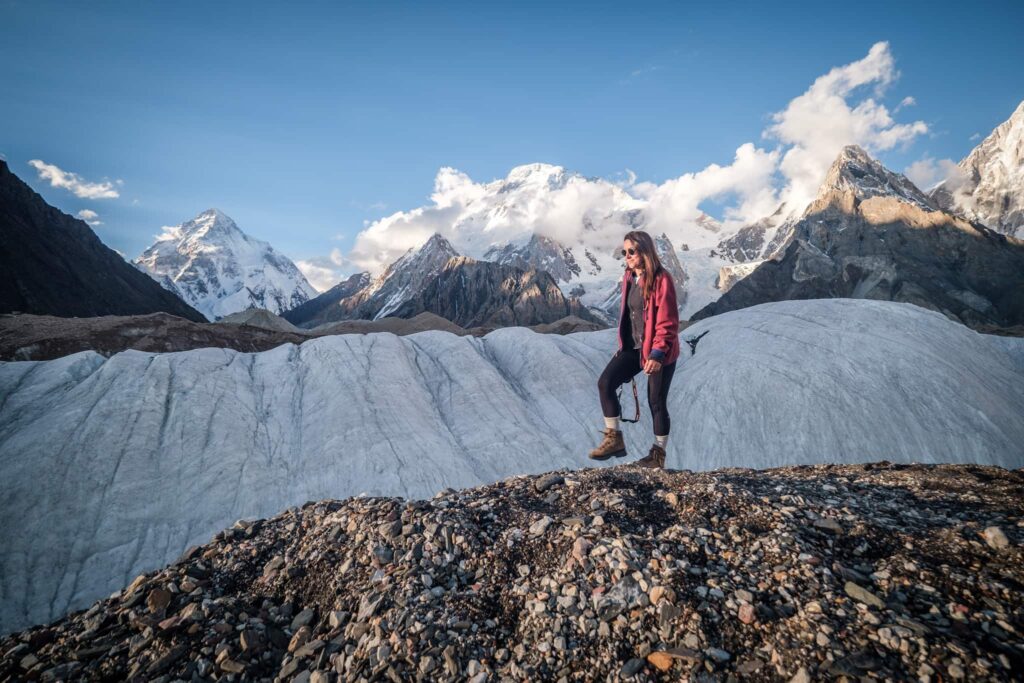
Alright! We’ve looked at both what the best materials for hiking socks are as well as the best hiking socks overall. Anything else?
Yes! Pro-tips. Like any part of outdoor life, knowledge is the key to success. For added comfort and care on the trail, try these tidbits on for size:
- Socks in rotation: Always bring at least two pairs of hiking socks on an overnight or multi-day hike—one for hiking and one for sleeping. Realistically, even those hyper conscious of weight can never have too many pairs of fresh socks.
- Dry on the go: And if you have multiple pairs of socks and one is damp, attach them to your backpack to dry as you hike. Even if you have one pair only, stringing them up to catch the wind and sun on breaks is still a net positive.
- Proper sock care: Then, after the hike, always air out your socks and wash them properly (without fabric softener). This will maintain their insulation and moisture-wicking properties.
- The right fit is key: It’s not just about choosing the best hiking sock material; it’s also about choosing the best fit. Measure up, test socks, and ensure your chosen pair is neither too tight to restrict circulation nor too loose to cause blisters. Plus, make sure they fit your type of boots, e.g. hiking or mountaineering socks for hiking or mountaineering boots, respectively.
- Accessorize: Lastly, consider thin liner socks under your main socks for extra comfort and blister protection on longer hikes. Or, for wet or snowy conditions, ankle gaiters can keep debris and moisture out of your socks and boots. It’s all about matching your fit to the trails ahead.
Wrapping Up: Hiking Sock Material Matters
Having the right hiking socks and material is what makes a good hike a great hike. (Or, to be frank, a miserable hike a bearable hike.)
Don’t believe us? Then go out there and hit a multi-day trail with a few pairs of cotton crew socks! After all, experience is wisdom, and that’s a quick way to learn.
As with all your best expedition gear, perfection only comes through practice and experimentation. There are plenty of types of socks built for both day hikes or longer backpacking trips. Any of the above recommendations will fit either adventure like a glove (or a sock!).
After all, there is nothing in life quite as pleasant as sliding on a fresh, clean, new pair of socks. So stack your pack with cushioned comfort!
Because when you’re out in the backcountry a million miles from home, it’s about the little creature comforts.

